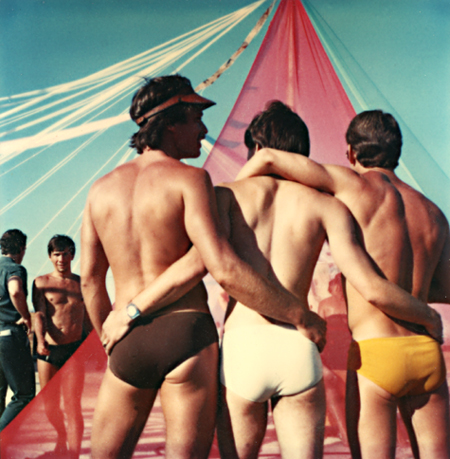|
Reviews of Recent Independent, Foreign, & Documentary Films in Theaters and DVD/Home Video
Directed by: Joseph Lovett. Produced by/Camera: Michael Sean Kaminsky & Joseph Lovett. Edited by: Jason Szabo. Music by: Art Labriola. Released by: Lovett Productions. Country of Origin: USA. 72 min. Not Rated.
For generations of gay men that came of age before 1969, cruising for sex was likely to be
associated with words like "shame" or phrases like "risk of violence." For those of us who came
of age after 1981, cruising is just as likely to be associated with the risk of contracting HIV. But
for the men featured in this lively documentary, cruising was simply "Trying to meet someone" -
a furtive social phenomenon that had developed into a boldface attitude of "Here it is, take it."
Men cruised and engaged in sex in New York City bars, bathhouses, piers and in parked trucks in
the Meatpacking District.
Gay Sex in the 70s is notable for putting all the above into the context of the times -
from the repressed 1950s to the rise of gay pornography and disco in the ‘70s. The film also
shows how risk was involved, whether it was sexually transmitted diseases,
obsessive-compulsive behavior or drug abuse. Those interviewed include the likes of author
Larry Kramer and Larry Mass,who wrote about the emerging AIDS crisis in the New
York Native. Still, the tone of the interviews never sounds like that of a professor addressing
a classroom. Instead, we hear architect Scott Bromley admit, "I'm not a sociologist. But I think
[the sexual liberation of the ‘70s] was a natural progression. Suddenly, we were allowed." The
documentary does, however, stop short of a few issues. Though white men and black men are
often pictured together in archival footage, there's no discussion of race relations, or lack thereof,
among gay communities. And the line between the recreational drug use then and the current
crystal-meth epidemic isn't connected.
Filmmaker and crew also miss more than one chance to poeticize. Larry Kramer's novel
Faggots may be important historically, but a far more elegantly written passage from a far
better book (Andrew Holleran’s Dancer from the Dance for one) could have been chosen
to enhance the visuals. Towards the end, the camera follows artist Barton Benes to the now
gentrified West Side piers. Saying, "This is all that's left," he gestures toward some logs which
barely breach the river's surface and that look, for all the world, like so many drowning men. But
the camera just doesn't linger long enough. The look of Gay Sex in the 70s isn't slick
either, despite the fact that filmmaker Joseph Lovett was a 20/20 director/producer. This
is a more understandable failing. Lovett has, after all, dug up a wealth of fading archival film and
photographic stills that, for all their graininess, still bring back the age in all its shocking glory,
even for those of us who witnessed its last days. Steven Cordova, contributing editor and poet (Slow Dissolve, Momotombo Press)
|
